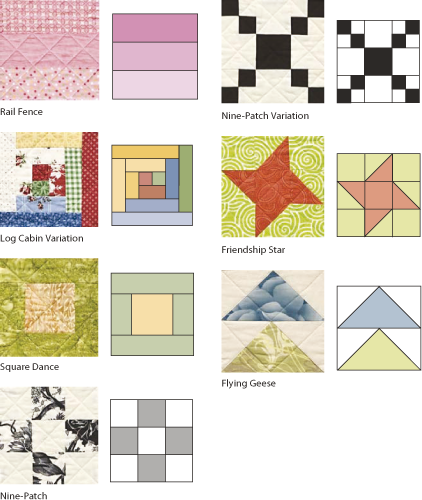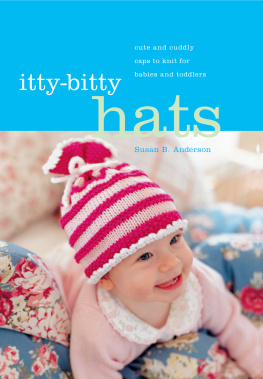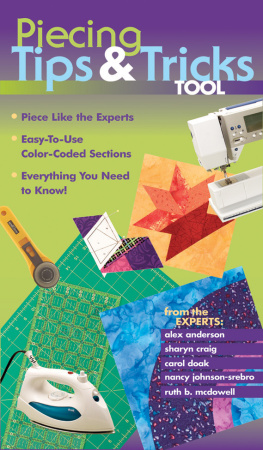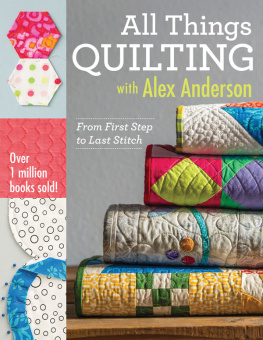
1997, 2001 by Alex Anderson Text copyright 2009 by Alex Anderson Artwork copyright 2009 by C&T Publishing, Inc. Publisher: Amy Marson Creative Director: Gailen Runge Editor: Liz Aneloski Technical Editor: Sandy Peterson Copyeditor/Proofreader: Wordfirm Inc. Cover/Book Designer: Kristy K. Zacharias Production Coordinator: Kirstie L. Pettersen Photography by Christina Carty-Francis and Diane Pedersen of C&T Publishing, Inc., unless otherwise noted. Published by C&T Publishing, Inc., P.O.
Box 1456, Lafayette, CA 94549 All rights reserved. No part of this work covered by the copyright hereon may be used in any form or reproduced by any meansgraphic, electronic, or mechanical, including photocopying, recording, taping, or information storage and retrieval systemswithout written permission from the publisher. The copyrights on individual artworks are retained by the artists as noted in Start Quilting with Alex Anderson. These designs may be used to make items only for personal use or donation to nonprofit groups for sale. Each piece of finished merchandise for sale must carry a conspicuous label with the following information: Designs copyright 2009 by Alex Anderson from the book Start Quilting with Alex Anderson from C&T Publishing, Inc. Attention Teachers: C&T Publishing, Inc., encourages you to use this book as a text for teaching. Contact us at 800-284-1114 for more information about the C&T Teachers Program.
We take great care to ensure that the information included in our products is accurate and presented in good faith, but no warranty is provided nor are results guaranteed. Having no control over the choices of materials or procedures used, neither the author nor C&T Publishing, Inc., shall have any liability to any person or entity with respect to any loss or damage caused directly or indirectly by the information contained in this book. For your convenience, we post an up-to-date listing of corrections on our website ( or at P.O. Box 1456, Lafayette, CA 94549. Trademark () and registered trademark () names are used throughout this book. Rather than use the symbols with every occurrence of a trademark or registered trademark name, we are using the names only in the editorial fashion and to the benefit of the owner, with no intention of infringement.
Library of Congress Cataloging-in-Publication Data Anderson, Alex. Start quilting with Alex Anderson: everything first-time quilters need to succeed: 8 quick projects-most in 4 sizes. 3rd ed. p. cm. ISBN 978-1-57120-812-5 (paper trade) 1.
PatchworkPatterns. 2. QuiltingPatterns. 3. Patchwork quilts. Title. Title.
TT835.A5234 2009 746.46041dc22 2009004907 Printed in China 10 9 8 7 6 5 4 3 2 1 Dedication To Pam Vieira-McGinnis, queen celebrity stunt sewer. Thank you for your keen eye and swift handsthis book would not have been possible without you. Acknowledgments Thank you to Todd and Tony Hensley for your continued support; Liz Aneloski for keeping me on track and for being so generous with your time; Mark Aneloski for being my project carrier pigeon; Olfa, Omnigrid, P&B Textiles, Moda Fabrics, Maywood Studio, Hoffman Fabrics, and Superior Threads for providing excellent products; Erica for your eagle eye; Cindy Carvalho and my friends at Alden Lane Nursery for your help and support; John Vitale for your creative eye; John who puts up with my crazy lifestyle; and last but not least, my cousin Lauren Marlotte for her killer poppy seed cake. Contents Introduction A quilt is like a sandwich. It has three layers: The quilt top is usually made of many 100% cotton fabrics that are cut in various sizes and then sewn together, either by hand or by machine. This is called piecing.
The middle layer, called the batting, is usually either polyester or cotton. The backing is another piece of 100% cotton fabric. Cotton fabric is usually 42 wide; so, if your quilt top exceeds 42 in width, you will need to sew pieces of fabric together (piece) to create a wide enough piece of fabric for the backing. All three layers are then stitched together, either by hand or by machine, uniting all three components (pieced top, batting, backing) as one. This is called quilting. I can remember the first quilt I ever made.
My grandma started a Grandmothers Flower Garden quilt in the 1930s and was pleased as punch when I expressed a desire to finish it. What she didnt know was that I was one month and one unit short of graduating from college, and I had contracted the project to fulfill that requirement. I had not only a fantasy of graduating with a bachelors degree in art, but also dreams of snuggling under my hand-pieced and hand-quilted queen-size quilt on a cold winter night. Needless to say, I graduated, but with a quilt the size of a bath mat. Although I had originally planned to be a weaver, visions of quilts danced in my head. As they say, The rest is history.
Im a quilter for life. I love quilts. During the past three decades, I have been fortunate enough to be a participant in the renaissance and evolution of quiltmaking into a sophisticated art form that offers many different avenues to explore. At The Quilt Show (www.thequiltshow.com), Ricky Tims and I present expert quilters who share their latest techniques or approaches to quiltmaking. This craft keeps getting more innovative, and there is always a new method on the horizon. I can remember when the quilting world was introduced to rotary cutters, and now we can generate quilts on computers, scan images to print our own fabric, and connect with other quilters worldwide! Whether this time-honored craft has reached its peak is often discussed.
Are there any new quilters out there? The answer is yes, and it is you! I am often asked where a person interested in quilting should begin. So I decided to write this book to get the beginning quilter started with the basics. You must remember that there are many different approaches to quiltmaking, and one is not better than the others, just different. What this book provides is an introduction to the world of rotary-cut quiltmaking (as opposed to the templates that my grandma used), with eight simple wall quilts you can complete using seven basic 6 6 finished quilt blocks. Fabric requirements are based on standard 42-wide fabric. The term finished means that this is the size after the piece has been sewn into the quilt.
This size no longer includes the seam allowances. Thus, a 6 6 block becomes 6 6 finished block once it has been sewn into the quilt. I recommend that you start with a small project as your first quilt. You will be able to finish it and feel successful. I find that when first-time quilters start with a large project, the whole process becomes overwhelming, and they either give up in frustration or lose the enjoyment of the process. Besides, if you start small, you can begin another quilt sooner.
I will teach you how to make the following seven quilt blocks.  These seven blocks consist of three of the most basic shapes quilters work with all the time: squares, rectangles, and triangles.
These seven blocks consist of three of the most basic shapes quilters work with all the time: squares, rectangles, and triangles.
If you find that you really enjoy making one of these patterns, you can make more blocks to complete a larger quilt any size you want (see chart below). The width of the borders is just a suggestion; trust your eye to determine the border width that works for your quilt. See Appendix A () for yardage requirements and cutting instructions for twin, double/queen, and king comforter-style quilts to augment the projects in this book. My hope for you is that through making these projects, you will become familiar with the basics of quiltmaking and develop into a quilt lover, as I have. 





















 1997, 2001 by Alex Anderson Text copyright 2009 by Alex Anderson Artwork copyright 2009 by C&T Publishing, Inc. Publisher: Amy Marson Creative Director: Gailen Runge Editor: Liz Aneloski Technical Editor: Sandy Peterson Copyeditor/Proofreader: Wordfirm Inc. Cover/Book Designer: Kristy K. Zacharias Production Coordinator: Kirstie L. Pettersen Photography by Christina Carty-Francis and Diane Pedersen of C&T Publishing, Inc., unless otherwise noted. Published by C&T Publishing, Inc., P.O.
1997, 2001 by Alex Anderson Text copyright 2009 by Alex Anderson Artwork copyright 2009 by C&T Publishing, Inc. Publisher: Amy Marson Creative Director: Gailen Runge Editor: Liz Aneloski Technical Editor: Sandy Peterson Copyeditor/Proofreader: Wordfirm Inc. Cover/Book Designer: Kristy K. Zacharias Production Coordinator: Kirstie L. Pettersen Photography by Christina Carty-Francis and Diane Pedersen of C&T Publishing, Inc., unless otherwise noted. Published by C&T Publishing, Inc., P.O.  These seven blocks consist of three of the most basic shapes quilters work with all the time: squares, rectangles, and triangles.
These seven blocks consist of three of the most basic shapes quilters work with all the time: squares, rectangles, and triangles.